One of the most important techniques of grape farming is tying on trellises. This technique is necessary for the formation of vines, support heavy berry brushes, as well as for uniform supply of sunlight to all branches of the vine. For the manufacture of trellis, you can hire a team of builders or install them yourself. Let's figure it out together how to make supports for grapes with your own hands.
Content
Why do you need support
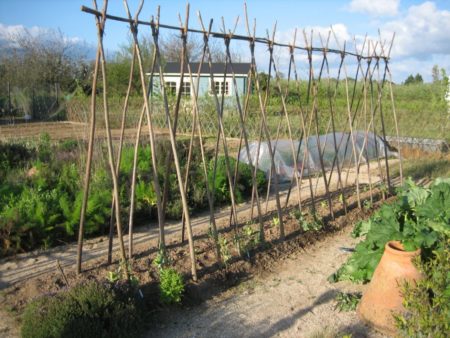 The vine is by its nature a vine, the branches of which without support are not able to grow vertically. The branches lying on the ground rot from excess moisture, the leaves on them turn yellow from a lack of solar energy, the berries ripen small. Plants straightened on the trellis are better heated and illuminated, thereby receiving more nutrition from the sun. The use of support for the vine brings the fruiting period closer and increases the sugar content of the berries.
The vine is by its nature a vine, the branches of which without support are not able to grow vertically. The branches lying on the ground rot from excess moisture, the leaves on them turn yellow from a lack of solar energy, the berries ripen small. Plants straightened on the trellis are better heated and illuminated, thereby receiving more nutrition from the sun. The use of support for the vine brings the fruiting period closer and increases the sugar content of the berries.
Advantages of growing vines on supports:
- vertical vine cultivation allows the use of compacted planting;
- vertical cultivation provides maximum illumination of each leaf. This speeds up plant photosynthesis and increases productivity;
- even illumination of berries increases their sweetness and sugar content;
- vertically raised branches are well ventilated. Good ventilation protects plants from fungal diseases. As a result, the need for laborious spraying of plants with chemical solutions is reduced.
Choosing a place to plant grapes
Grapes are very thermophilic, so a well-lit place is chosen to organize the vineyard. Plants should not be placed near buildings that give a dense shadow. Landings should be protected from the north winds by a fence or a stone wall. The roots of the grapes go into the ground for several meters, so a high level of groundwater can lead to the death of plants.
Tapestry Materials
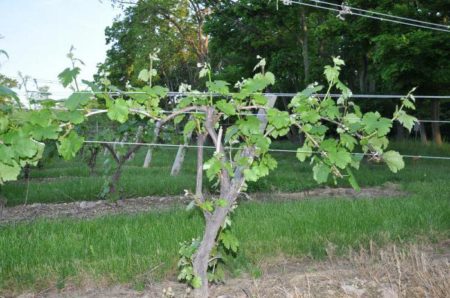 Gardeners use any available materials as supports. For support poles may be suitable:
Gardeners use any available materials as supports. For support poles may be suitable:
- metal and polypropylene pipes;
- corners, channels;
- wooden posts or timber.
To tie the vines to the trellis, a variety of wire, an electric wire in plastic insulation, a fishing line or a nylon cord are used.
Necessary tools
To work successfully, you need an appropriate tool kit. The choice and quantity of the tool depends entirely on the materials used in the work:
- for marking the material you need a tape measure, square, level, water level, pencil, marker;
- for working with plastic pipes - a welding machine for pipes, a hacksaw;
- for the manufacture of metal structures - welding machine, angle grinder (grinder), drill, drill, bolt and nut;
- for working with wood - a chainsaw, hammer, screwdriver, nails, self-tapping screws;
- for carrying out anticorrosive and antiseptic works - brushes, roller;
- for excavation and concrete work - concrete mixer, measuring buckets, shovels and bayonet shovels, concrete tray;
- to tie the vines to the trellis - scissors, knife, nippers.
Trellis Options
In the cultivation of grapes, three main types of trellis are used: single-plane, double-plane and arched. Each of them is designed for its climate and its technology for growing plants.
Single-plane
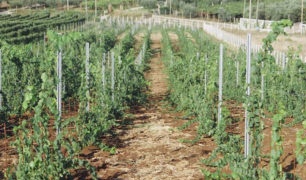 The simplest solution is a single-plane design. For its manufacture, they dig in columns in one row and pull 3-4 rows of wire between them, to which later branches of the vine are attached. The height of the pillars is made equal to 170 - 220 cm, the distance between them is 3 - 4 meters. For pulling, a wire with a diameter of 3 mm is used, which is attached to the posts every 40 to 50 cm.
The simplest solution is a single-plane design. For its manufacture, they dig in columns in one row and pull 3-4 rows of wire between them, to which later branches of the vine are attached. The height of the pillars is made equal to 170 - 220 cm, the distance between them is 3 - 4 meters. For pulling, a wire with a diameter of 3 mm is used, which is attached to the posts every 40 to 50 cm.
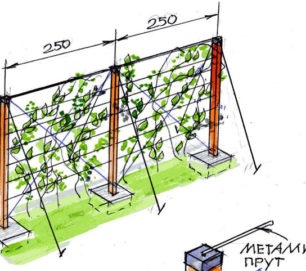 Advantages of a single-plane design:
Advantages of a single-plane design:
- low cost of materials;
- fast trellis construction;
- good ventilation and lighting branches.
Disadvantages of a single-plane design:
- low planting density;
- a garter on single-plane supports is absolutely not suitable for tall varieties with a large number of branches.
L-shaped or semi-arched support
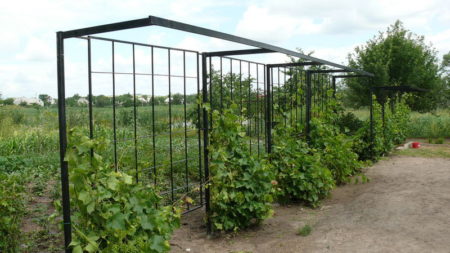 A kind of single-plane design is a support in the form of the letter G or a half-arch. It is used for the manufacture of fences, screens and small half-sunshades for the organization of a recreation area in small personal plots. This type of support is well suited for plants with active growth of green mass. In the northern regions, growing plants on L-shaped supports helps to catch additional sunlight from the leaves of plants.
A kind of single-plane design is a support in the form of the letter G or a half-arch. It is used for the manufacture of fences, screens and small half-sunshades for the organization of a recreation area in small personal plots. This type of support is well suited for plants with active growth of green mass. In the northern regions, growing plants on L-shaped supports helps to catch additional sunlight from the leaves of plants.
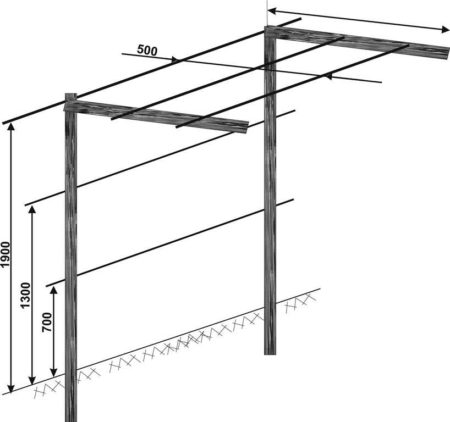
Two-plane T-shaped
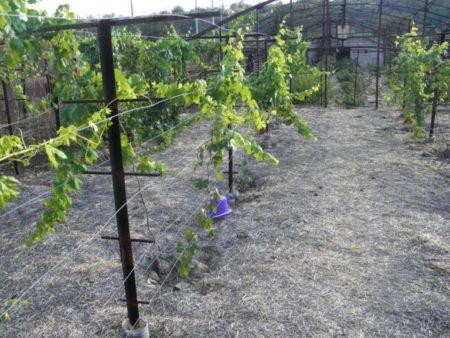 Two-plane designs are necessary for productive grape varieties. The branches of the vine tied to this design are distributed in several tiers, thereby evenly illuminating the foliage.
Two-plane designs are necessary for productive grape varieties. The branches of the vine tied to this design are distributed in several tiers, thereby evenly illuminating the foliage.
- two-plane garter provides good illumination and ventilation of the bushes;
- the garter provides good access to flowers for pollinating insects;
- this method provides a high density of plant growth;
- well-formed plants bear fruit abundantly;
- powerful shrubs give an abundant shadow, so the soil under them always remains moist.
Two-plane supports are made in the form of the letter Y or T. In the first embodiment, the supporting strips are attached to the column at an angle of 45 degrees, in the second - at an angle of 90 degrees. The height of the posts is 160-200 cm, the horizontal span is up to 150 cm. The distance between the posts in a row is 3 meters.
Two-plane V-shaped
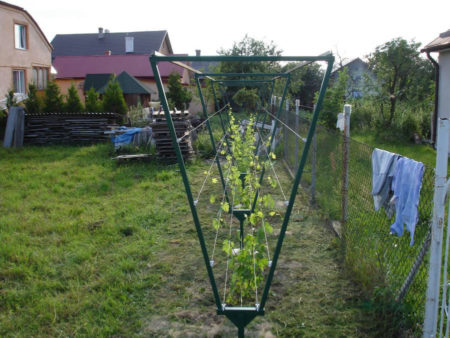
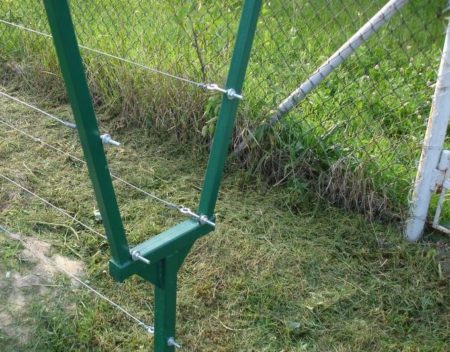 A two-plane design is considered more complicated, in which the poles are dug in two in one hole, installing with a slope in the form of the letter V. To fix the angle of inclination of the posts, the pits are concreted. The distance between the posts in the lower part of the letter V is 40-50 cm, in the upper part - 100 - 110 cm. The height of the posts is 180 - 200 cm. A distance of 5-7 meters is maintained between the pairs of posts. Between the posts, a wire with a diameter of 3 mm is pulled through 50 cm.
A two-plane design is considered more complicated, in which the poles are dug in two in one hole, installing with a slope in the form of the letter V. To fix the angle of inclination of the posts, the pits are concreted. The distance between the posts in the lower part of the letter V is 40-50 cm, in the upper part - 100 - 110 cm. The height of the posts is 180 - 200 cm. A distance of 5-7 meters is maintained between the pairs of posts. Between the posts, a wire with a diameter of 3 mm is pulled through 50 cm.
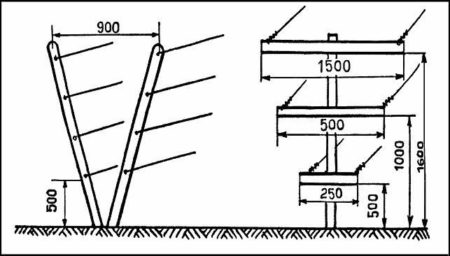
Arched structures
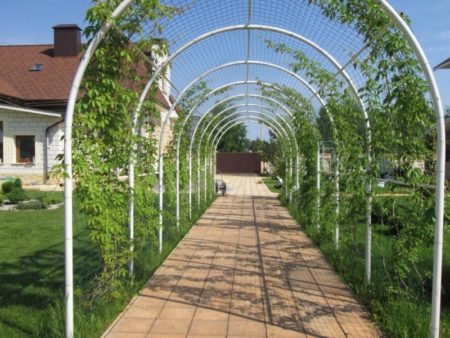 The installation of arched supports for the vines is used to create arbors, alleys, screens or garden rooms in the garden. For growing on supports of this design, tall varieties are suitable, growing up to 4-5 meters in height. For a beautiful design of the arch, long branches of plants must be directed along the outer perimeter of the structure.
The installation of arched supports for the vines is used to create arbors, alleys, screens or garden rooms in the garden. For growing on supports of this design, tall varieties are suitable, growing up to 4-5 meters in height. For a beautiful design of the arch, long branches of plants must be directed along the outer perimeter of the structure.
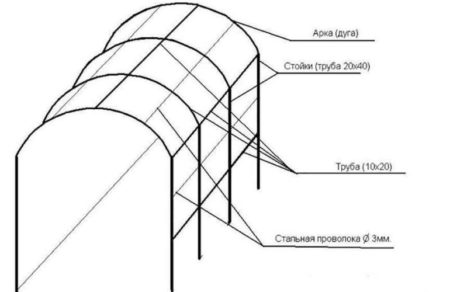 As a rule, arches are made in the factory from a bent metal profile.Particularly beautiful are the openwork forged designs produced by the forge workshops. Due to the fact that semicircular arch structures are difficult to manufacture at home, the cost of manufacturing structures from such supports is quite high. The most budgetary version of the arch support is a canopy of straight U-shaped pillars.
As a rule, arches are made in the factory from a bent metal profile.Particularly beautiful are the openwork forged designs produced by the forge workshops. Due to the fact that semicircular arch structures are difficult to manufacture at home, the cost of manufacturing structures from such supports is quite high. The most budgetary version of the arch support is a canopy of straight U-shaped pillars.
Self-made direct single-plane trellis
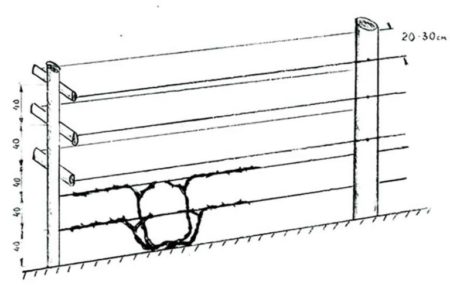 Self-production of a single-plane support takes very little time. For fast and high-quality work, it is necessary to act according to the following algorithm:
Self-production of a single-plane support takes very little time. For fast and high-quality work, it is necessary to act according to the following algorithm:
- At the installation site of the future fence, marking is carried out, the contours of the future support are outlined, the cord is pulled.
- They dig a hole, a depth of 40-50 cm, a pillar is installed in it. As a pillar, take a wooden beam or a piece of log; a metal or PVC pipe; metal profile or corner. The length of the column is 2.5 meters. The column is aligned vertically in level, the pit is poured with concrete.
- After the concrete has hardened, the column is marked up to tension the cable. The first mark is made at a height of 50 cm, the subsequent after 40 cm.
- In the marking places in wooden or PVC columns, screws are screwed. Holes with a diameter of 6-8 mm are made in metal columns and bolts are inserted.
- Having departed 3 meters from the first, the following columns are installed.
- For horizontal strapping take a metal cable in a polyvinyl chloride sheath. It is attached to the posts with bolts or screws.
Grape formation
Grape formation necessary for uniform distribution of the support and prevent thickening of the branches. The formation method is chosen based on the climatic characteristics of the region, grape varieties and the location of the site. For a long time growing crops developed several options for the formation of plants.
Sleeve forming
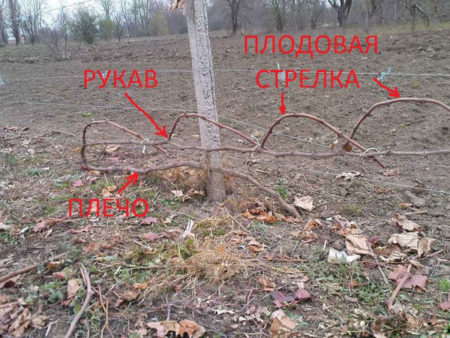 The advantage of this method is the dense placement of plants on a support. A sleeve is a branch that a vine grower leaves in the spring for fruiting. The formation process is carried out every spring. In the first year of life, plants choose several pairs of strong branches growing nearby, the rest are cut out. In each pair, three buds are left on the first branch, and nine on the second. The ends of the branches are cut. A longer branch begins to bear fruit abundantly in the second year, it is cut in autumn. In the autumn of the second year, the two strongest shoots are found on a short branch, the rest are cut out. Next, the formation is carried out, leaving one shoot for fruiting, and the second for replacement. A similar process is carried out every year.
The advantage of this method is the dense placement of plants on a support. A sleeve is a branch that a vine grower leaves in the spring for fruiting. The formation process is carried out every spring. In the first year of life, plants choose several pairs of strong branches growing nearby, the rest are cut out. In each pair, three buds are left on the first branch, and nine on the second. The ends of the branches are cut. A longer branch begins to bear fruit abundantly in the second year, it is cut in autumn. In the autumn of the second year, the two strongest shoots are found on a short branch, the rest are cut out. Next, the formation is carried out, leaving one shoot for fruiting, and the second for replacement. A similar process is carried out every year.
Fan system of vine formation
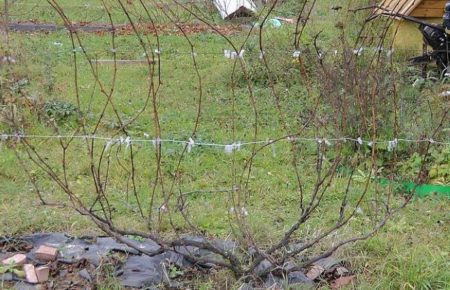 The fan system of vine formation differs from the sleeve quantity of branches-sleeves left for fruiting. With the correct system, in the first year of life, plants leave 5-6 pairs of branches, tying them to a support in the form of a fan. Next, the formation of the sleeves is carried out, leaving in each pair of branches one for substitution, and the second for fruiting. Thus, a powerful plant is formed with a large number of fruit-bearing branches, from which a large crop is obtained.
The fan system of vine formation differs from the sleeve quantity of branches-sleeves left for fruiting. With the correct system, in the first year of life, plants leave 5-6 pairs of branches, tying them to a support in the form of a fan. Next, the formation of the sleeves is carried out, leaving in each pair of branches one for substitution, and the second for fruiting. Thus, a powerful plant is formed with a large number of fruit-bearing branches, from which a large crop is obtained.
Vines
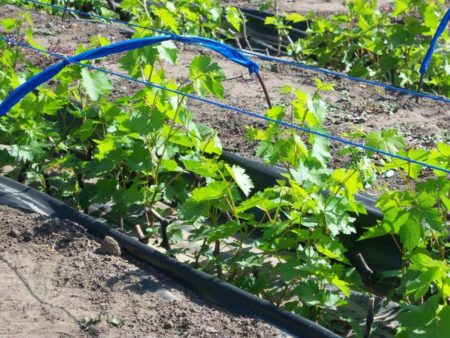 Garter of the vine is necessary for the formation of the plant and, subsequently, to obtain a good harvest. In order not to break the branches when carrying out the tying, care must be taken. Grape growers practice two main methods of garter.
Garter of the vine is necessary for the formation of the plant and, subsequently, to obtain a good harvest. In order not to break the branches when carrying out the tying, care must be taken. Grape growers practice two main methods of garter.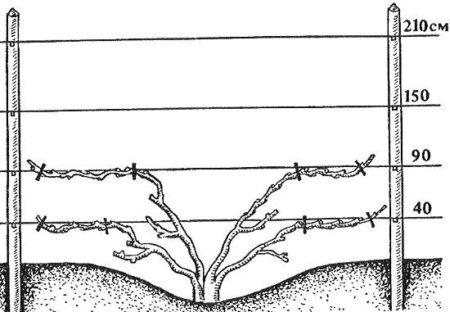
"Dry" garter branches
With the “Dry” tying to the wire, the trellis is attracted and the last year’s dry branches are attached, which grow next to the trellis. By tying the old branches to the wire of the support, the winegrower forms the “skeleton” of the tree.
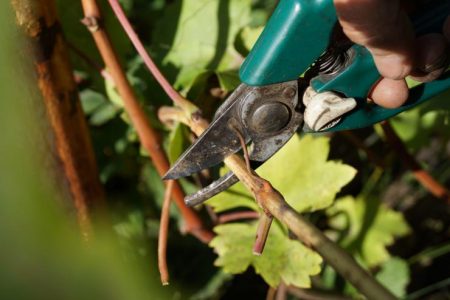
How to prepare grape cuttings in autumn
Gardeners do not have much time to relax, because in the spring it is necessary to start planting vegetables and fruits, as well as ...
Green garter of young shoots
During the "Green" tying, young branches 35-40 centimeters long are attracted to the wire. Flexible branches can be tied at any angle, evenly filling the entire area of the support. After the shoots reach the next level of wire the garter is repeated. Formed in this way, the plant receives the maximum amount of solar energy.
Reviews
Nikolay 43 years
We made a gazebo on our site - arched canopy. A metal corner was dug into the ground, a strapping was made at the top, and a ceiling of a square profile was laid on it. The entire building was made of a conventional metal profile, so its cost was very low.
Elena, 36 years old
Instead of a fence, we have single-plane trellises with grapes around the garden. We let the vine through the wire in a fan pattern. The result of the work is a beautiful fence and a plentiful harvest every year.
Conclusion
To install the trellis and garter on them the vine will not require either a lot of time or a large amount of tool. The supports correctly installed and treated with protective compounds serve for many years, and properly formed and tied plants on them please the hosts with a plentiful harvest.




 Non-covering winter-hardy grape varieties for Moscow region
Non-covering winter-hardy grape varieties for Moscow region How to keep the vine in winter
How to keep the vine in winter When can I transfer grapes to another place in the fall
When can I transfer grapes to another place in the fall How to cover and prepare grapes for the winter in the suburbs
How to cover and prepare grapes for the winter in the suburbs